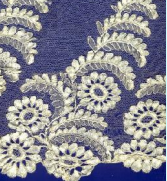 |
| Lace made at Broadlands |
In 1827, Nunn's Lace Factory
* was opened on the Isle of Wight. The factory was placed in Staples, Newport,
a remote location, to keep its machinery that made fine French Blonde lace from
prying eyes.
 |
| Pink silk lace dress Queen Victoria wore |
This factory located in what
is Broadlands House today was one of the largest employers on the Island. The
factory made a profit for some years. Queen Victoria and other ladies of the
court were among its customers.
The lace it produced was as
fine as a spider web and expensive but when tastes in fashion changed the
factory lost business. By 1870, William Henry Nunn retired and having no son to
leave the factory to, the business closed.
This left 200 men, women,
boys and girls without a means of support.
In 1880 the old factory was used
by a charitable establishment for 40 “poor spinsters and widow ladies who had
fallen on hard times.” This charity also trained young working class girls as
servants to be placed in positions around Newport.
Tragically one of these girls
was killed at Broadlands in a fire in January of 1904. Alice Barton was 14
years old when she was left alone in the matron’s sitting room. She stood on a
fender near the fireplace to reach some papers when an ember from the fire
dropped on her dress.
The fabric on her dress
quickly ignited. Alice suffered severe burns and she died.
The charity closed in the
1930s and in 1949 Broadlands was bought by England’s Ministry of Labour.
 |
| Broadlands House today. |
Ghosts do not always appear
at opportune times. Linzi Mathews would agree with this statement. In 1982,
Linzi worked for the Department of Health and Social Security at Broadlands
House.
One afternoon as she sat on
the toilet in the first floor ladies room she saw a foot appear at the bottom
of the door. But the door that enclosed her stall went all the way to the
floor. It was if someone was walking right through it.
The small foot was wearing an
old-fashioned shoe, pointed, grey in color and decorated with buttons. Above
the shoe she could see a lace-trimmed petticoat.
She sat frozen too scared to
open the door and see what was on the other side. Seconds later, she watched as
the shoe vanished. Gathering her wits she opened the door but no one else was
in the room despite the fact she still felt a presence.
When Linzi mentioned this
encounter to her coworkers she was told that the Broadlands ghost had been
seen, heard and even smelled over the years.
A strong odor of toast often
accompanied appearances by this ghost. Staff
members told her they often heard footsteps in the upper empty rooms late in the afternoon.
Knocking sounds and furniture
being moved about was also heard on the top landing of the Broadlands House.
So who was the ghost that
Linzi saw? Some feel it was Alice Barton who died in the fire, or maybe it was
another distressed young women fallen on hard times that stayed at the house.
Linzi still wonders if the
lace trim she saw was made at Broadlands when it was the 1800s Isle of Wight
lace factory.
 |
| Traverse warp |
* J. Brown and George Freeman
invented the lace making machinery—known as a traverse warp, they agreed to
take a banker’s son—W. H. Nunn on as a partner with his father’s support who
was a Nottingham banker.

No comments:
Post a Comment
Comments are moderated. If comment does not pertain to post it will not be published. If there is a link within comment it will not be published.